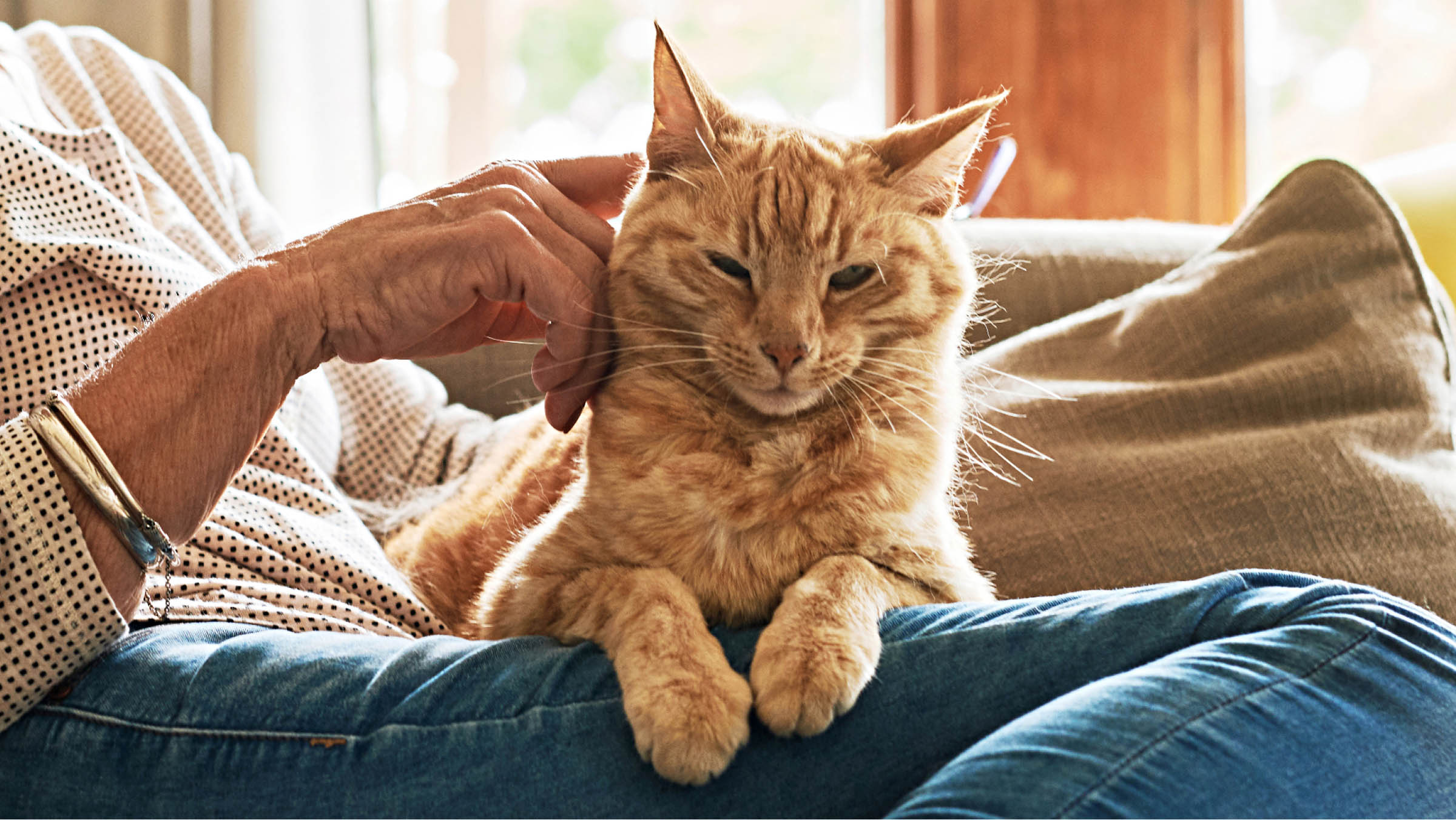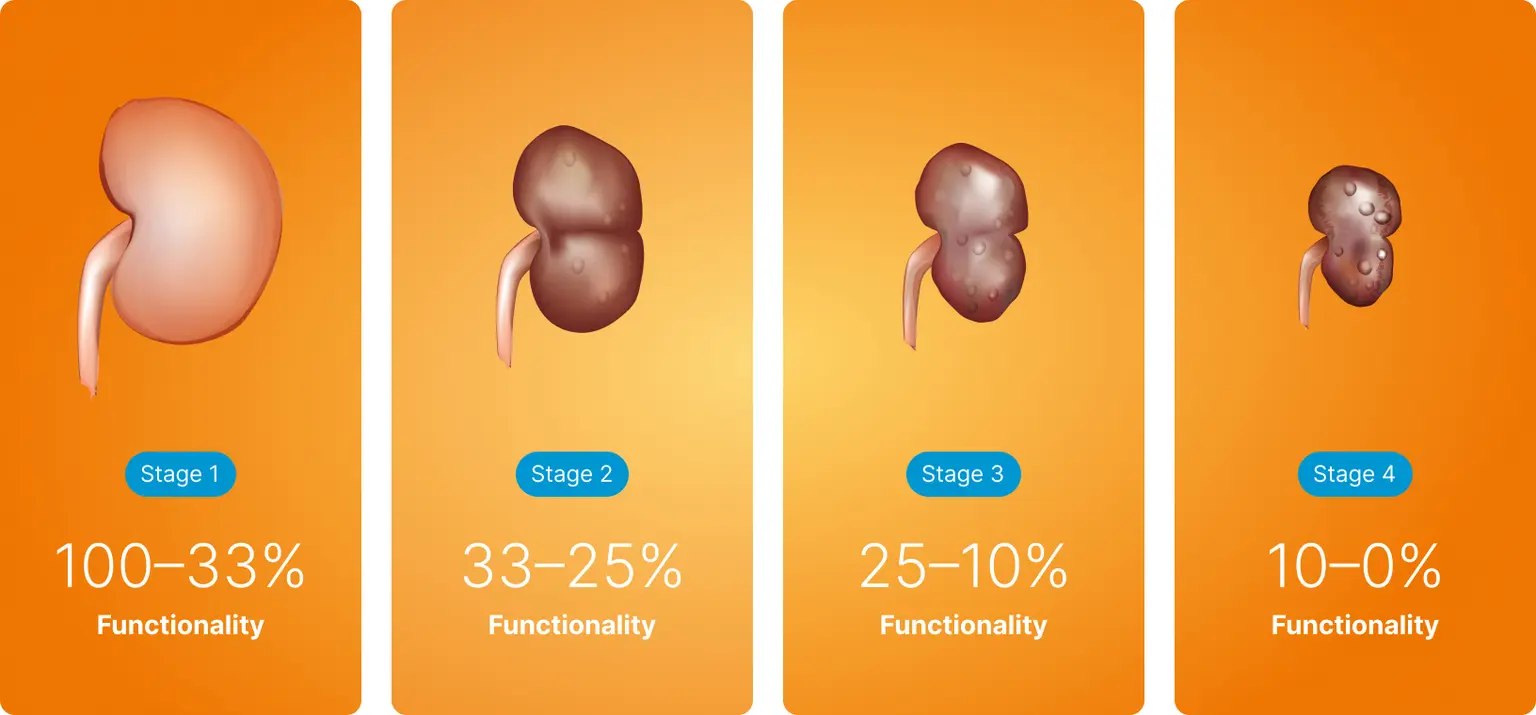
Chronic kidney disease
Chronic kidney disease (CKD) in cats. Has your cat been your loyal friend and companion for a long time? It's easy to forget that your feline friend may already be quite old. Thanks to good care and medical treatment, the life expectancy of our domestic cats has increased significantly. They can live up to 15 years or more.
Unfortunately, the longer cats live, the higher the risk of age-related diseases such as chronic kidney disease ("CKD" for short). It is estimated that one in three cats over the age of 15 is affected.¹ And just like ageing itself, unfortunately you can't always see the disease in your cat.
Important to know: CKD is a chronic disease in which kidney function slowly declines. This is why early diagnosis and a quick start to treatment are essential. This is the only way to slow down the progression and maintain your cat's quality of life for as long as possible.

DEFINITION
What is CKD?
Just like you, your cat has two kidneys that work as filters and remove substances that are no longer needed from the body. Each of these kidneys consists of around 200,000 small filter units, also known as nephrons. The blood in the body is pumped through the kidneys several hundred times a day and processed there. Once purified, it flows back into the organism. Excess water, toxins and waste products from the body's normal metabolism are first collected in the urinary bladder via the renal pelvis and the ureter and then excreted as urine via the urethra.

In chronic kidney disease, the renal corpuscles, which are part of the nephrons, are damaged. The kidneys try to compensate for this loss by increasing the performance of the still-intact nephrons. Compared to other animals and humans, cats have relatively few nephrons and their kidney capacity is therefore exhausted more quickly. The overload causes more nephrons to die and the kidneys can no longer fulfil their function adequately. This affects the elimination of metabolic waste products, the regulation of the electrolyte and acid-base balance and the blood pressure. Ultimately, CKD causes urinary intoxication (uremia). This is characterised by an increasing accumulation of toxins in the body.
Unfortunately, CKD cannot be cured, so the kidney function of a diseased cat will gradually deteriorate - to the point of kidney failure. Cat specialists therefore recommend annual routine kidney checks by the veterinarian for every cat from the age of 7 at the latest. This is the only way you can react early.

Kidney check
Are you unsure whether your cat could be suffering from kidney disease? The following questions can help you to correctly assess your furry friend's symptoms and recognize signs of possible disease at an early stage.
SYMPTOMS
How can I recognize CKD?
CKD often progresses in stages: there are phases in which the cat feels good, but the state of health can also suddenly deteriorate. The signs can be different and vary from cat to cat. This means, that the disease can remain undetected for a long time. Only when more than two thirds of the kidney cells are already damaged do more serious symptoms of the disease appear.
Especially if your faithful companion is already older, you should keep a close eye on it and consult your veterinarian even if there are slight changes in its behavior. The first signs are often increased drinking and changes in urination.
Also look out for the following signs, which can occur with CKD, but also with other diseases:
- Increased drinking
- Frequent urination
- No appetite
- Weight loss
- Fatigue
- Vomiting
- Diarrhea
- Poor coat care
- Dull, matted coat
- Crawls away from you, does not want to be petted
- No interest in playing
- Listlessness
- Bad breath
- Dehydration
- Dull, sunken eyes
Caution!
If your cat does not drink enough water, there is a risk of dehydration. This is an absolute emergency and must be treated immediately! A simple test helps to recognize dehydration: carefully pull up a fold of skin on your cat's neck or chest wall with two fingers. If it immediately falls back into place, everything is fine. In the event of dehydration, the fold of skin will remain longer than normal. You can also test this on yourself for comparison.
CAUSES
What causes CKD?
It is often difficult to determine the exact trigger for chronic kidney disease, as the diagnosis can often only be made at a late stage. By that time, the trigger is usually no longer detectable. However, it is assumed that past events, which can even date back years, lead to CKD. These include
- Kidney inflammation
- Harmful effects caused by foreign substances
- Circulatory disorders
- Genetic defects
Too little fluid intake in cats can also contribute to the development of CKD.
DIAGNOSIS
How is CKD diagnosed?
If your cat is suspected to have chronic kidney disease, the veterinarian will first carry out a thorough examination.
Additional tests such as blood and urine tests or an ultrasound examination of the kidneys can then be carried out to diagnose chronic kidney disease (CKD) with certainty or, in the best case, to rule it out. A complete blood count is essential here: waste products from normal metabolism (such as urea and creatinine) are no longer sufficiently excreted in the urine in the case of chronic kidney disease and can therefore accumulate in the blood. Increased creatinine and urea levels, together with changes in other blood values such as the kidney marker SDMA (symmetric dimethylarginine), indicate whether your cat may have CKD. Certain trace and bulk elements such as sodium or phosphate also indicate kidney disease.
In a sick cat, these blood tests are repeated at regular intervals. This allows changes to be detected and the veterinarian can assess whether the patient is responding well to treatment.
Your cat's urine can also provide information about kidney function and the severity of CKD. For example, the blood, protein and sugar levels in the urine are examined. CKD is then classified into stages based on the test results:
Classification of CKD in Cats

Chronic kidney disease is usually divided into four stages according to IRIS staging². IRIS stands for International Renal Interest Society, a group of international kidney specialists. They have defined standards for the diagnosis and treatment of CKD in cats and dogs. The respective stage of the disease (IRIS 1 - 4) gives an indication of how far the damage to the kidneys has already progressed. The veterinarian uses this classification when monitoring your cat and can thus assess, for example, whether the course of the disease is stable or progressing.
In order to classify a cat into one of the four stages, the creatinine level in the blood must be tested repeatedly.
As many cats with chronic kidney disease also have high blood pressure, your pet's blood pressure should be checked regularly. Imaging procedures such as X-rays or ultrasound can also be helpful. This allows the veterinarian to see changes in the shape, structure and position of the kidneys and other abdominal organs in your four-legged friend.

TREATMENT
How can CKD be treated?
As destroyed kidney tissue cannot be replaced, CKD cannot be cured. However, the earlier the disease is diagnosed and treated, the greater the chances of preserving your cat's kidney function for a long time and enabling it to continue to lead a good life.
This is also the aim of all therapeutic measures. First of all, the food is changed to a kidney diet. In the case of special dietary food, the protein, salt and phosphate content is reduced. This takes the strain off your cat's kidneys. It is also best to feed your cat wet food, as this will increase its fluid intake.
For accompanying symptoms of CKD such as high blood pressure or an elevated phosphate level, antihypertensive or phosphate-binding medication is prescribed. Your veterinarian will discuss the best treatment for your cat with you based on the test results.
And you can also do something for your cat's vitality and quality of life: talk to your veterinarian about how to rebalance your cat's energy metabolism and support kidney function.
Heel Vet
If you want to support your cat, consider the natural veterinary medicines from Heel Vet.
PREVENTION
How can I prevent CKD?
The most important recommendation for CKD: start prevention early. A kidney check is ideal as soon as the cat is fully grown. However, every cat should have an annual kidney check from the age of 7 at the latest!
The kidneys can only do their job if the animals drink enough water. However, this is often a problem with cats as they naturally drink very little. Yours too? Then wet food is better than dry food. You can also enrich water with diluted cat milk or a small drop of tuna oil - this may make drinking more appealing. It's best to offer several drinking areas, as some cats prefer running water, such as from a drinking fountain.
Some additives have to be excreted via the kidneys; minerals promote the formation of crystals in the bladder if they accumulate in the urine. It is best to discuss the correct feeding with your veterinarian.
There are substances that damage the kidneys, such as in lilies or antifreeze (ethylene glycol). These should not be accessible to your cat. You should also keep medicines and foods that are poisonous to cats (e.g. grapes/raisins, garlic and onions) out of "paw reach".
What else helps?
You know your pet best! Keeping a close eye on your cat, taking action when changes occur and attending regular check-ups at the veterinary clinic are the best preventative measures.
Sources:
1 Geddes et al., 2013
2 IRIS Kidney – Guidelines – IRIS Staging of CKD (iris-kidney.com)


